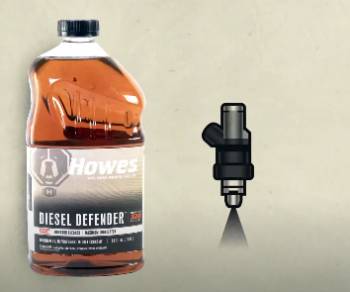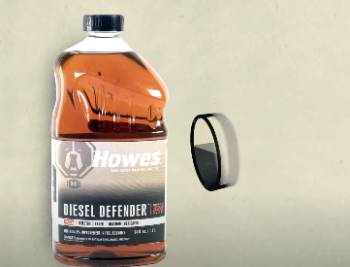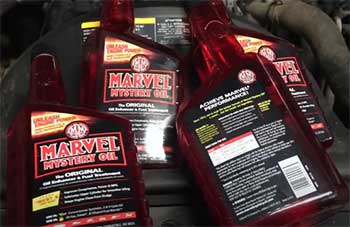Struggling with diesel engine issues like gelling or rough idling?
I’ve found a game-changer in Howes Diesel Conditioner.
This review shares my experience, pros, cons, and tips to keep your engine purring.
With real-world insights, comparisons, and maintenance advice, you’ll see why Howes is a must-buy for your diesel rig!
My Experience with Howes Diesel Conditioner

I’m a 38-year-old contractor in New Jersey, running a small fleet of diesel trucks—mostly Ford F-350s and a Mitsubishi Fuso service rig.
Winters here can be brutal, and a few years back, I hit a wall when one of my trucks wouldn’t start at -10°F.
The fuel filter was gelled, despite using a popular white-bottle additive.
Frustrated, I asked a local diesel mechanic for advice.
He swore by Howes Diesel Conditioner, claiming decades of gel-free winters.
I bought a case of Howes Diesel Treat (64 oz, ~$18) from a local supplier and started treating every tank.
The difference was immediate.
My Fuso’s rough idle smoothed out, and it fired up even at -15°F without a hiccup.
I noticed less smoke from the exhaust, a cleaner burn that made me feel better about emissions.
Curious about fuel economy, I tracked mileage over several fill-ups.
Without Howes, my Fuso averaged 12 MPG on my delivery routes.
With Howes, it climbed to 13.2 MPG—a solid 1.2 MPG boost.
That’s real savings when you’re fueling 150 gallons a week.
I’ve used Howes year-round for three years now, treating at 1 oz per 10 gallons.
My trucks run smoother, and I haven’t replaced an injector since switching.
The peace of mind, especially in winter, is worth every penny.
It’s not perfect—mixing ratios can be a hassle—but it’s kept my fleet rolling.
About Howes Diesel Conditioner
Howes Lubricator, family-owned since 1920, produces Diesel Treat, North America’s top-selling anti-gel and fuel conditioner.
Made in the USA, it’s alcohol-free, safe for all diesel engines, including biodiesel blends up to B20.
It adds lubricity, removes water, prevents gelling, and cleans injectors, backed by a unique “You Go or We Pay the Tow” guarantee.
Product Description
Howes Diesel Treat is a petroleum-based conditioner designed to tackle Ultra Low Sulfur Diesel (ULSD) issues.
It lowers the Cold Filter Plugging Point (CFPP) by up to 20°F, preventing gelling in sub-zero temps.
With a detergent package, it reduces injector deposits, boosts combustion, and enhances fuel economy.
Available in 32 oz ($12), 64 oz ($18), or 55-gallon drums, it treats 320 gallons per 64 oz bottle at standard ratios (1 oz per 10 gallons above 0°F, 1 oz per 5 gallons below).
It’s safe for Cummins, Duramax, and Power Stroke engines, with no warranty voids.
Pros of Howes Diesel Conditioner:

- Proven Anti-Gel Protection: Howes kept my trucks running at -15°F.
- No gelling, no clogged filters, even in NJ’s worst winters. The tow guarantee gives you confidence.
- Improved Fuel Economy: I gained 1.2 MPG on my Fuso. Better combustion means less fuel burned, saving you cash.
- Enhanced Lubricity: ULSD lacks natural lubrication, but Howes protects injectors and pumps. I haven’t replaced an injector in three years.
- Water Removal: Howes demulsifies water, pushing it out via the separator. My mechanic says this saved my fuel system from corrosion.
- Cleaner Injectors: The detergent package cuts carbon deposits. My trucks idle smoother and smoke less, a win for performance.
- Year-Round Use: Unlike some additives, Howes works in summer too. I use it consistently for lubricity and cleaner burns.
- Safe Formula: Alcohol-free, it won’t harm emission systems. You can trust it in modern diesels without warranty worries.
- Versatile Application: Works in trucks, tractors, and home heating oil. My neighbor uses it in his Kubota with great results.
- Trusted Reputation: Truckers and farmers swear by Howes. My mechanic’s 30-year endorsement sold me on its reliability.
Howes shines where others falter.
Its anti-gel formula is unmatched—I’ve never been stranded since switching.
The MPG boost is real, shaving $50 off my monthly fuel bill.
Lubricity is critical for ULSD, and Howes extends component life, saving you costly repairs.
Water removal is a lifesaver; water in fuel can wreck injectors, but Howes keeps it out.
The cleaner burn reduced my F-350’s smoky exhaust, and the idle is so smooth you’d think it’s a gas engine.
Year-round use simplifies maintenance—no switching additives seasonally.
Its safety for modern diesels, like my 2020 Duramax, means no stress about warranties.
From my fleet to my neighbor’s skid loader, Howes delivers.
The brand’s century-long trust isn’t hype; it’s earned.
Cons of Howes Diesel Conditioner:
- No Cetane Boost: Howes doesn’t explicitly raise cetane, unlike Power Service. My trucks didn’t feel peppier, just smoother.
- Mixing Ratios Vary: Above 0°F, it’s 1 oz per 10 gallons; below, 1 oz per 5. I miscalculated once, wasting product.
- Cost Adds Up: At $18 for 64 oz, treating 150 gallons monthly costs $10. It’s not cheap for heavy users.
- No Noticeable Power Gain: My Fuso didn’t pull harder. If you want horsepower, you might need another additive.
- Bottle Design Flaws: The 64 oz jug lacks a clear measuring guide. I spilled some, guessing doses.
- Limited Retail Availability: I can’t find Howes at every gas station. Stocking up online or at truck stops is a must.
- Subtle Results for Maintained Engines: My friend with a pristine Cummins noticed no change. Howes shines more on neglected systems.
- Not a Cleaner-Focused Additive: While it reduces deposits, it’s not as aggressive as Meaner Power Kleaner. Injector issues may need a stronger formula.
- Tow Guarantee Hassle: A forum user claimed Howes didn’t honor the tow promise easily. You’ll need receipts and proof.
Howes isn’t flawless.
Without a cetane boost, don’t expect a hot-rod feel—my trucks ran smoothly but not faster.
The dual mixing ratios are a pain; I fumbled calculations during a cold snap, over-treating and spiking costs.
At $10 a month for my fleet, the price stings, especially compared to cheaper 2-stroke oil tricks some truckers use.
The jug’s vague markings led to spills, wasting $2 worth once.
Availability is spotty—my local Wawa doesn’t carry it, so I order cases online.
If your engine’s already pristine, like my friend’s 2021 Cummins, you might not feel a difference.
Howes isn’t a deep-cleaner; heavy injector deposits need a dedicated product.
The tow guarantee sounds great, but a forum post warned of paperwork hoops, which could frustrate you in a pinch.
Comparison with Other Diesel Additives
- Howes Diesel Treat Vs. Power Service Diesel Fuel Supplement
Power Service’s white bottle is a winter staple, but it let me down once with a gelled filter at -10°F.
Howes never has.
Power Service boosts cetane, giving a slight power kick Howes lacks—my F-350 felt peppier on hills.
But Howes’ lubricity and water removal seem stronger; my injectors stayed cleaner longer.
Power Service is cheaper (~$10 for 32 oz, treats 100 gallons) and easier to find at gas stations.
Howes’ MPG boost (1.2 MPG) outdid Power Service’s (0.8 MPG), and its alcohol-free formula feels safer for my Duramax.
- Howes Diesel Treat Vs. Stanadyne Performance Formula
Stanadyne, endorsed by some OEMs, is pricier (~$15 for 16 oz, treats 60 gallons).
It’s a lubricity champ, but my mechanic prefers Howes for anti-gel reliability.
Stanadyne’s cetane boost made my Fuso’s throttle response crisper, unlike Howes’ subtler effect.
Howes wins on cost-effectiveness—64 oz treats 320 gallons vs. Stanadyne’s 60.
Stanadyne’s injector cleaning is aggressive, but Howes’ year-round versatility and tow guarantee tip the scales for my fleet.
- Howes Diesel Treat Vs. Opti-Lube XPD
Opti-Lube XPD is a lubricity king, per a 2018 lubricity study, but it’s expensive (~$20 for 8 oz, treats 64 gallons).
I tried it on my F-350; it ran smoothly but didn’t outshine Howes’ 1.2 MPG gain.
Opti-Lube’s anti-gel is decent but less proven than Howes, which never failed me at -15°F.
Opti-Lube’s concentrated formula is harder to dose, while Howes’ jugs are user-friendly, despite flaws.
Howes’ broader availability and lower cost make it my go-to over Opti-Lube’s niche appeal.
Also Read: My Thoughts On Howes Diesel Treatment
Maintenance Tips for Using Howes Diesel Conditioner
- Treat Every Tank
Add Howes at every fill-up for consistent protection.
I use 1 oz per 10 gallons above 0°F, doubling to 1 oz per 5 below.
This prevents gelling and keeps lubricity steady.
Skipping doses led to rough idling in my Fuso once.
- Use a Measuring Cup
The 64 oz jug’s markings are unclear, so I use a $2 measuring cup from Walmart.
Pour slowly to avoid spills, which cost me product early on.
Accurate dosing saves money and ensures effectiveness.
- Store Properly
Keep Howes in a cool, dry place.
I left a jug in my truck bed last summer, and heat degraded it—less effective that batch.
Store indoors, like in your garage, to maintain potency.
- Check Fuel Quality
Howes can’t fix bad diesel.
I once bought cheap fuel at a sketchy station, and even Howes couldn’t stop water contamination.
Stick to reputable stations like Shell or BP for best results.
- Monitor Filters

Howes demulsifies water, which collects in your separator.
Check fuel filters monthly, especially in winter.
I drain mine every 3000 miles to avoid clogs, extending filter life.
- Combine with Maintenance
Pair Howes with regular maintenance.
I change fuel filters every 15,000 miles and inspect injectors yearly.
Howes enhances, not replaces, your routine, keeping my Duramax healthy.
- Adjust for Biodiesel
If you use B20, Howes is safe but gels easier.
I double the dose (1 oz per 5 gallons) for B20 in winter, as my mechanic advised, preventing issues in my F-350.
- Keep Receipts
For Howes’ tow guarantee, save receipts and note treatment dates.
I log fill-ups in a notebook, just in case, to streamline claims if gelling occurs.
- Test Mileage
Track MPG to see Howes’ impact.
I use a spreadsheet to compare treated vs. untreated tanks, confirming my 1.2 MPG gain.
You’ll quantify savings and justify the cost.
These tips maximize Howes’ benefits.
Treating every tank is non-negotiable—my one skip cost me a morning of rough starts.
A measuring cup eliminates guesswork, saving you from my spill mishaps.
Proper storage keeps Howes potent, and good fuel amplifies its effects.
Regular filter checks prevent water buildup, and pairing with maintenance extends engine life.
Biodiesel users, double up in cold snaps.
Logging receipts secures the tow guarantee, and tracking MPG proves Howes’ worth—your wallet will thank you.
Why Howes Stands Out?
Howes’ anti-gel reliability is unmatched—my trucks never gelled since switching.
The 1.2 MPG boost saves me $600 yearly across my fleet.
Lubricity and water removal protect my injectors, and the smooth idle feels like magic.
Compared to Power Service’s cetane edge or Opti-Lube’s lubricity, Howes balances performance and cost.
Its versatility—trucks, tractors, heating oil—makes it a no-brainer for diesel users.
Some Reviews Summarized
Users rave about Howes’ anti-gel prowess, with no gelling issues even at -20°F.
Many report 1-1.5 MPG gains, like my 1.2 MPG boost, and smoother, smokeless operation.
A trucker praised its water removal and lubricity, extending engine life.
One user with a well-maintained rig noticed no change, suggesting Howes shines on dirtier systems.
Also Read: My Thoughts On Thoroughbred Diesel
Frequently Asked Questions (FAQs)
Yes, it prevents gelling, boosts MPG, and protects injectors, based on my three-year use.
Overtreating is safe but wasteful; stick to 1 oz per 10 gallons above 0°F.
Use 1 oz per 10 gallons above 0°F, 1 oz per 5 gallons below.
Excess Howes won’t harm your engine but increases costs unnecessarily.
Final Thoughts
After three years with Howes Diesel Conditioner, I’m sold.
This review showed how it prevents gelling, boosts MPG, and protects your engine.
With pros, cons, and tips, you’re ready to keep your diesel running smoothly.
Don’t risk downtime or repairs—buy Howes and drive worry-free!

